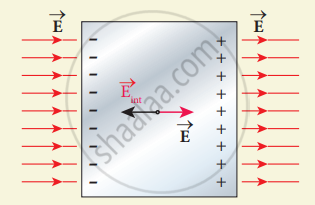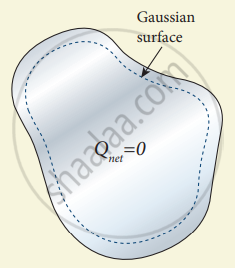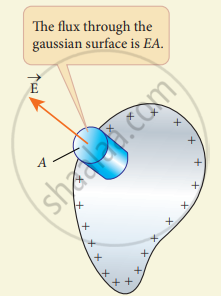Advertisements
Advertisements
प्रश्न
Discuss the various properties of conductors in electrostatic equilibrium.
उत्तर
-
The electric field is zero everywhere inside the conductor. This is true regardless of whether the conductor is solid or hollow. This is an experimental fact. Suppose the electric field is not zero inside the metal, then there will be a force on the mobile charge carriers due to this electric field.
As a result, there will be a net motion of the mobile charges, which contradicts the conductors being in electrostatic equilibrium. Thus the electric field is zero everywhere inside – the conductor. We can also understand this fact by applying an external uniform electric field on the conductor.

Electric field of conductorsBefore applying the external electric field, the free electrons in the conductor are uniformly distributed in the conductor. When an electric field is applied, the free electrons accelerate to the left causing the left plate to be negatively charged and the right plate to be positively charged.
Due to this realignment of free electrons, there will be an internal electric field created inside the conductor which increases until it nullifies the external electric field. Once the external electric field is nullified the conductor is said to be in electrostatic equilibrium. The time taken by a conductor to reach electrostatic equilibrium is in the order of 10-6s, which can be taken as almost instantaneous.
- There is no net charge inside the conductors. The charges must reside only on the surface of the conductors. We can prove this property using Gauss law. Consider an arbitarily shaped conductor. A Gaussian surface is drawn inside the conductor such that it is very close to the surface of the conductor.

No net charge inside the conductor
Since the electric field is zero everywhere inside the conductor, the net electric flux is also zero over this Gaussian surface. From Gauss’s law, this implies that there is no net charge inside the conductor. Even if some charge is introduced inside the conductor, it immediately reaches the surface of the conductor.
- The electric field outside the conductor is perpendicular to the surface of the conductor and has a magnitude of `σ/ε_0` where a is the surface charge density at that point. If the electric field has components parallel to the surface of the conductor, then free electrons on the surface of the conductor would experience acceleration. This means that the conductor is not in equilibrium. Therefore at electrostatic equilibrium, the electric field must be perpendicular to the surface of the conductor.

The electric field on the surface of the conductor
We now prove that the electric field has magnitude `sigma/ε_0`
just outside the conductor’s surface. Consider a small cylindrical Gaussian surface. One-half of this cylinder is embedded inside the conductor. Since electric field is normal to the surface of the conductor, the curved part of the cylinder has zero electric flux. Also inside the conductor, the electric field is zero. Hence the bottom flat part of the Gaussian surface has no electric flux. Therefore the top flat surface alone contributes to the electric flux. The electric field is parallel to the area vector and the total charge inside the surface is σA. By applying Gauss’s law,
EA = `(sigma"A")/ε_0`
In vector from, `vec"E" = sigma/ε_0 hat"n"
Here n represents the unit vector outward normal to the surface of the conductor. Suppose σ < 0, then electric field points inward perpendicular to the surface.
-
The electrostatic potential has the same value on the surface and inside of the conductor. We know that the conductor has no parallel electric component on the surface which means that charges can be moved on the surface without doing any work. This is possible only if the electrostatic potential is constant at all points on the surface and there is no potential difference between any two points on the surface. Since the electric field is zero inside the conductor, the potential is the same as the surface of the conductor. Thus at electrostatic equilibrium, the conductor is always at equipotential.
APPEARS IN
संबंधित प्रश्न
Write a short note on ‘electrostatic shielding’.
What is polarisation?
What is dielectric strength?
Explain the process of electrostatic induction.
Explain dielectrics in detail and how an electric field is induced inside a dielectric.
An electron and a proton are allowed to fall through the separation between the plates of a parallel plate capacitor of voltage 5 V and separation distance h = 1 mm as shown in the figure.
- Calculate the time of flight for both electron and proton.
- Suppose if a neutron is allowed to fall, what is the time of flight?
- Among the three, which one will reach the bottom first?
(Take mp = 1.6 x 10-27 kg, me= 9.1 x 10-31 kg and g = 10 m s-2)
